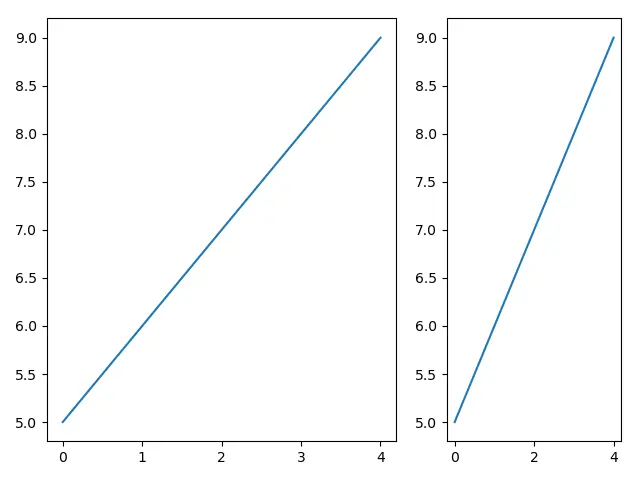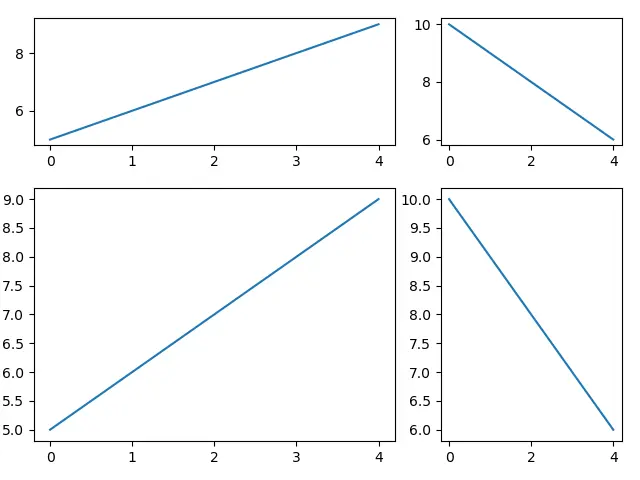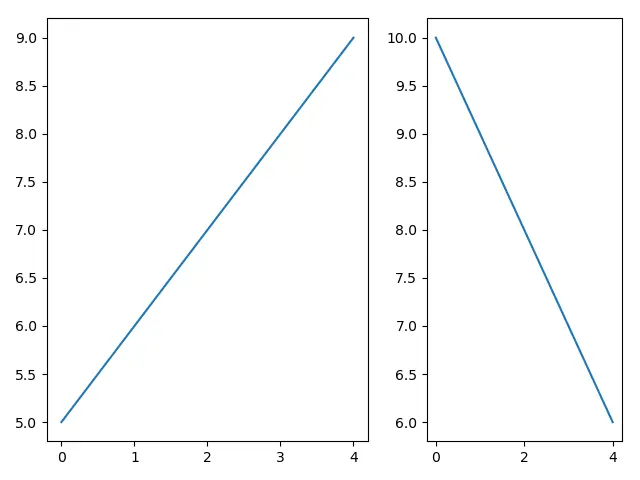Matplotlib 中如何创建不同大小的子图 subplot

我们可以使用 gridspec_kw,gridspec 和 subplot2grid 指定不同比例的子图来创建不同大小的子图。

gridspec 方法
import matplotlib.pyplot as plt
from matplotlib import gridspec
fig = plt.figure()
spec = gridspec.GridSpec(ncols=2, nrows=1, width_ratios=[2, 1])
ax0 = fig.add_subplot(spec[0])
ax0.plot(range(5), range(5, 10))
ax1 = fig.add_subplot(spec[1])
ax1.plot(range(5), range(5, 10))
plt.show()
来自 gridspec 模块的 GridSpec 指定了子图网格的几何形状。我们可以设置行数,列数和布局参数,例如宽度和高度比。
spec = gridspec.GridSpec(ncols=2, nrows=1, width_ratios=[2, 1])
它指定图形具有两列和一行,并且宽度比为 2:1。
ax0 = fig.add_subplot(spec[0])
如上所述,ax0 对象在地物中的位置为 0,或者可以使用 spec[0, 0] 使它更清晰。
gridspec_kw 方法
import matplotlib.pyplot as plt
fig, ax = plt.subplots(
2, 2, gridspec_kw={"width_ratios": [2, 1], "height_ratios": [1, 2]}
)
ax[0][0].plot(range(5), range(5, 10))
ax[0][1].plot(range(5), range(10, 5, -1))
ax[1][0].plot(range(5), range(5, 10))
ax[1][1].plot(range(5), range(10, 5, -1))
plt.show()

gridspec_kw 是具有 GridSpec 构造函数关键字的字典,用于指定子图的网格。
宽度比指定为 2:1,高度比设置为 1:2。
subplot2grid 方法
subplot2grid 允许子图在网格索引中占用多个单元格。
def subplot2grid(shape,
loc,
rowspan=1,
colspan=1,
fig=None,
**kwargs):
shape 是网格的形状,具有 2 个整数的序列,其第一个元素是行数,第二个元素是列数。
loc 是 axis 放置在网格中的位置。它也是 2 个整数的序列,其第一个元素是行号,第二个元素是列号。
rowspan 和 colspan 是 axis 向右(rowspan)或向底部(colspan)跨越的行数或列数。
工作代码示例:
import matplotlib.pyplot as plt
fig = plt.figure()
ax0 = plt.subplot2grid((1, 5), (0, 0), colspan=3)
ax1 = plt.subplot2grid((1, 5), (0, 3), colspan=2)
ax0.plot(range(5), range(5, 10))
ax1.plot(range(5), range(10, 5, -1))
plt.show()

ax0 = plt.subplot2grid((1, 5), (0, 0), colspan=3)
ax1 = plt.subplot2grid((1, 5), (0, 3), colspan=2)
网格的形状为 (1, 5),具有一行五列。
ax0 位于 (0, 0) 单元格中,占据 3 列,而 ax1 位于 (0, 3) 中,并且占据其他两列。
Founder of DelftStack.com. Jinku has worked in the robotics and automotive industries for over 8 years. He sharpened his coding skills when he needed to do the automatic testing, data collection from remote servers and report creation from the endurance test. He is from an electrical/electronics engineering background but has expanded his interest to embedded electronics, embedded programming and front-/back-end programming.
LinkedIn